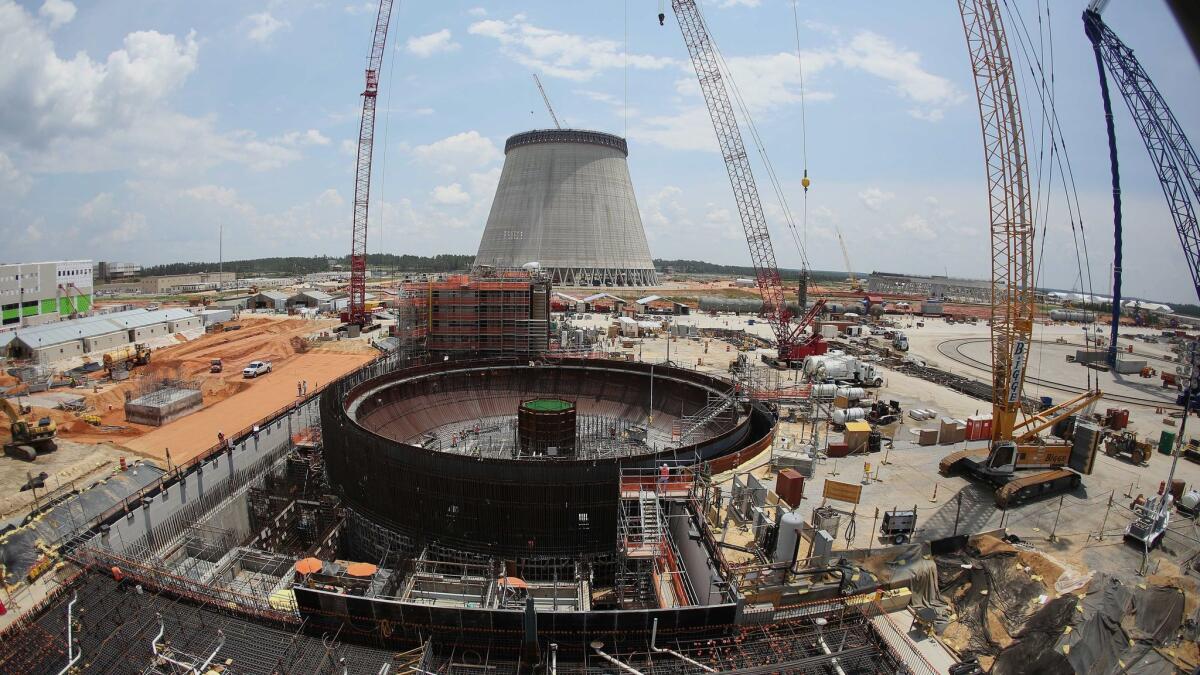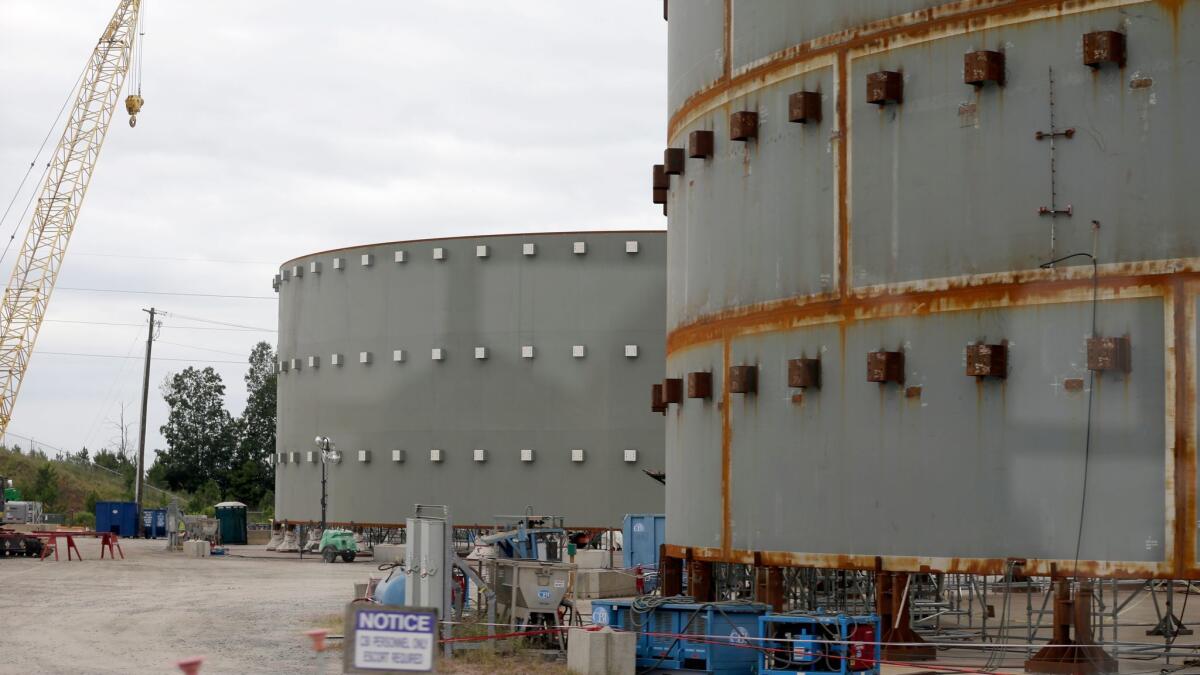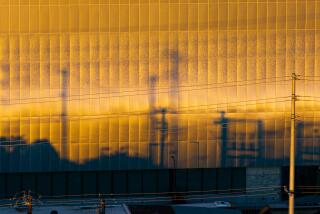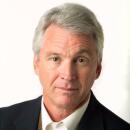Soaring costs and cheap natural gas deal more setbacks to the nuclear power industry

- Share via
The nuclear energy industry has had a bad couple of weeks.
On July 31, utilities in South Carolina announced that they are stopping work on two new reactors at the V.C. Summer Nuclear Generating Station, saying cost estimates came to more than $20 billion, almost twice what was expected. About $9 billion has already been spent on the project since 2008.
Then, two days later, developers of another nuclear project in the South — the Vogtle Electric Generating Plant in Georgia — announced costs had swelled from $14 billion to more than $25 billion and predicted completion will be delayed an additional 18 months.
The two announcements come at a particularly bad time for the industry.
No new nuclear power plants have been built in the United States for 30 years, the nation’s fleet of 99 reactors is getting older and 10 existing plants have announced plans to shut down in the coming years, including Diablo Canyon, the last remaining nuclear plant in California.
And earlier this year, Westinghouse Electric Company, long considered the leader in nuclear power development, filed for bankruptcy protection.
Then there is nuclear’s problem when it comes to competing with natural gas.
Driven by developments in hydraulic fracturing and horizontal drilling techniques, oil and gas producers in sites such as the Marcellus Shale formation have dramatically increased the amount of natural gas across the U.S.
The abundance has driven down prices, and utilities have increasingly turned to natural gas as an alternative to nuclear, as well as coal.
“I think what happened to the operating plants is the price of natural gas fell to levels that no one had ever predicted,” said Jay Silberg, a nuclear energy lawyer and partner at the Washington law firm of Pillsbury Winthrop.
Another factor is the increasing amount of renewable energy on the grid.
“It doesn’t surprise me at all that these plants are getting canceled,” said Rochelle Becker, a longtime critic of nuclear power and the executive director of the Alliance for Nuclear Responsibility, based in San Luis Obispo.
“They’re like very expensive dominoes that are falling. … With the price of natural gas and the availability of renewable and new sources that are continuing to hit the market, nuclear is pretty much dead in this country.”

According to the most recent numbers by the California Energy Commission, renewable energy made up 27.9% of in-state generation of electricity in 2016, almost twice as much as in 2009.
In addition, California is one of 28 states that have instituted Renewable Portfolio Standards (RPS), mandating utilities to include increasing amounts of clean-energy sources such as wind and solar into their grids.
The most recent iteration of California’s RPS calls for the state to derive 50% of its electricity from sources that do not emit carbon by 2030, and there’s a bill in the Legislature this session that would take the target all the way to 100% by 2045.
Like most states, California does not classify nuclear as part of its clean-energy portfolio.
Another stumbling block is the radioactive waste that accompanies nuclear power plants.
Even though the San Onofre Nuclear Generating Station has not produced electricity for more than five years, 3.55 million pounds of spent nuclear fuel remains at the plant within sight of the Pacific Ocean.
As seen at nuclear sites across the country, San Onofre waste has been stranded because the federal government has not fulfilled its promise to complete a storage facility where nuclear waste can be deposited.
But nuclear energy still has its supporters.
The projects in Georgia and South Carolina each adopted an advanced reactor design called AP1000 developed by Westinghouse. Though the design has its share of critics, a former president of the American Nuclear Society defended it.
“The AP1000 is an excellent technology,” said Ted Quinn, who runs a consultancy based in Dana Point. “In the area of technology, we’re good. In the area of construction practices, it’s a combination of the workforce and the type of contracts that are written. We’re challenged in that area.”
Quinn and others say nuclear energy needs to be retained because of its ability to ensure reliable base load power for the grid, and they maintain that the industry’s ability to generate large amounts of energy without emitting greenhouse gases makes it essential in reaching targets to reduce global warming.
“Without an aggressive buildout of nuclear power, climate goals are still attainable, but at much greater expense,” Jeffrey Sachs, director of the Sustainable Development Solutions Network, told Bloomberg News. “We’d make a big mistake if we decide right now we don’t need it.”
A report from Environmental Progress, a pro-nuclear environmental group based in Berkeley, said California’s power-sector emissions are 2 1/2 times higher today than they would have been had the state kept open and built planned nuclear plants.
Before San Onofre was shut down, nuclear power accounted for 18% of California’s in-state generation. Since it has been closed, the figure dropped to 9%, with Diablo Canyon as the only nuclear plant left. Natural gas’ contribution to the mix — and that of renewables — has gone up.
The Brattle Group, an international consulting company, came out with a study in December 2016 that said premature retirements of nuclear plants could increase greenhouse gas emissions. Its research showed that reductions made today have more impact than those made in the future.
“Since CO2 emissions persist for many years in the atmosphere, near-term emission reductions are more helpful for climate protection than later ones,” the study said. “Thus, preserving existing nuclear plants will improve the effectiveness of any climate policy approach, by holding down cumulative emissions.”
But Becker said nuclear’s waste issues blunt that argument.
“For 60 years we haven’t been able to find a solution to the waste that’s left behind at these nuclear plants,” she said. “What you have is very expensive back-end costs. In fact the back-end costs can be as large as the front-end costs.”
The nuclear industry sees promise in a new generation of plants, including “small modular reactors” (SMRs) that take up a fraction of the space of current facilities and can be used in a multitude of locations, including remote sites.
San Diego-based General Atomics has been working on what’s called the Energy Multiplier Module. But no SMRs are online yet. General Atomics hopes to have its project ready in 2030.
Internationally, the forecast is mixed.
Russia and China are building nuclear projects, with China expected to complete five new plants this year alone.
But Germany swore off nuclear power after the Fukushima disaster in Japan, and two countries that have embraced nuclear in the past may be making an about-face.
The environment minister in France said last month that the country may close up to 17 reactors to reduce its reliance on nuclear power and boost its amount of renewable energy, and South Korea just elected a new president who has promised to deemphasize nuclear power.
“We will abolish our nuclear-centered energy policy and move toward a nuclear-free era,” Moon Jae-In said in June.
For its critics, nuclear is becoming yesterday’s news.
“The future is not big, base-load plants,” Becker said. “It’s distributed generation and renewable and other energy that is on the table that we haven’t even talked about.”
But nuclear’s supporters see a brighter future, even if the present is problematic.
“I don’t think we’ll see large nuclear power plants in the near future,” Silberg said. “We may see SMRs if they in fact get designed and licensed. But I don’t think at this point in the next 15 or 20 years utility management is going to want to invest very much in a large nuclear plant project, unless of course natural gas prices go back up and the industry figures out how to overcome the problems that showed up at Vogtle and Summer.”
ALSO
China says it will ban North Korean coal and other goods under U.N. sanctions
A new all-electric delivery truck is on the way, and it’s not from Tesla
1,800 tons of radioactive waste has an ocean view and nowhere to go
More to Read
Inside the business of entertainment
The Wide Shot brings you news, analysis and insights on everything from streaming wars to production — and what it all means for the future.
You may occasionally receive promotional content from the Los Angeles Times.











